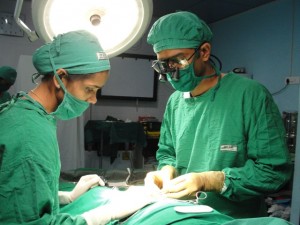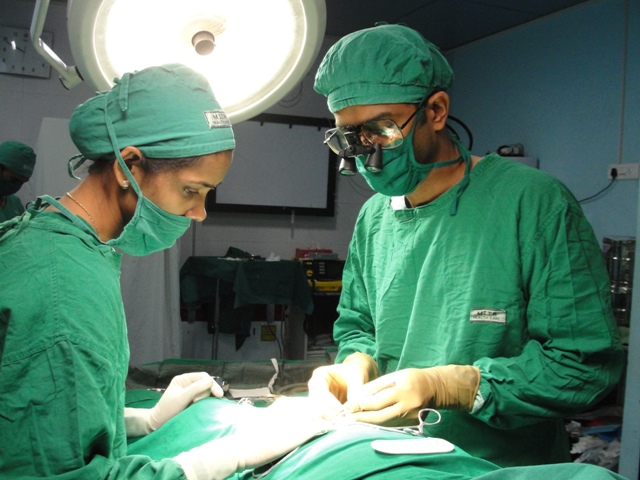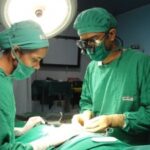Chordee means that the penis is bent (curved penis). Penis mostly gets bent downwards hence it is called ventral chordee and is seen commonly seen in children with hypospadias. In children with other type of anomaly which is much rarer than hypospadias called epispadias the penis may be bent upwards, it is called dorsal chordee. Hypospadias is atleast 20-30 times more common than epispadias, hence when someone uses the word chordee it is by fault supposed to mean ventral chordee as seen in hypospadias.
Why does chordee happen?
When the penis is getting formed between 8-12 weeks of pregnancy, the urethra (urinary passage) also starts getting formed from the base of penis to the tip of penis. This happens gradually under the 3influence of male hormones produced by the testis. All around urethra, a special tissue called corpus spongiosum is also formed through which the urethra runs. The two cylinders of tissue called corpus cavernosa are also formed. Together equal sizes of spongiosum and two cavernosa cylinder are responsible for a straight penis. When the urethra is short as in hypospadias, the spongiosum tissue is a3lso short, the skin and dartos tissue under skin is also short and sometimes the corpora can also be curved. Hence chordee results from this shortage of these tissues on underside of penis.
Do all hypospadias have chordee?
Chordee is seen more than 50% of all hypospadias but this also depends on the severity of hypospadias. Generally, the more severe the hypospadias is, higher the chances of chordee. Hence, chordee is more common in scrotal hypospadias than distal penile hypospadias. This is a generalization and it is not true in all cases as we have seen lot of cases of chordee without hypospadias and also minor hypospadias having a major degree of chordee.
How is chordee checked and graded?
Chordee can sometimes be seen by the parents when the child has an early morning erection which happens even in small babies. Generally we tell the parents to click the picture from the side to document the chordee degree. Chordee must always be checked during hypospadias surgery by doing an artificial erection test. This is infact a mandatory test for all hypospadias and the most important thing to be taken care of during hypospadias surgery. If chordee is not checked and left untreated, it can create lot of issues in adulthood and need surgery again which is much more difficult in adulthood. Chordee is graded in degrees like 30 degrees, 45 degrees or 90 degrees or also as mild, moderate or severe.
Does chordee always need surgery repair?
A straight penis is important to have straight stream of urine as well as for having normal sexual intercourse. Hence, if the penis has anything more than 15-20 degrees of bend should be corrected.
How is chordee repair surgery done?
- Degloving of penis: In any hypospadias surgery or chordee repair surgery, the first step is called degloving of penis. Degloving means that the penis skin is taken down till the base of penis by a circular incision around head of penis while saving the opening of hypospadias and urethral plate. Generally, there are some abnormal tissues around base of penis which cause chordee and once these are divided chordee gets corrected in most cases. Then a tourniquet is applied on the base of penis and saline solution is injected into the head of penis or corporal bodies. This is called artificial erection test and allows the hypospadias surgeon to assess the degree of chordee.
- Tunica albuginea plication: If there is still chordee then further steps need to be done to correct chordee. If the chordee is mild, then we perform tighten the top side of penis with a non-absorbable stitch to straighten the penis.
- Division of urethral plate: If the chordee is still severe then a cut needs to be given to divide the urethral plate between hypospadias opening and the head of penis.
- Dermal graft for chordee correction: Chordee is again checked and if it still severe then corpora needs to be lengthened by placing a dermal graft on underside of penis. In case a dermal graft is placed, then a single staged repair can’t be done and a staged hypospadias repair is done.
It is important for a hypospadias surgeon to make sure that the chordee is completely corrected during hypospadias surgery. It requires experience to do a stepwise assessment of the chordee in every individual case and then proceed with chordee repair as detailed above. The importance of having a straight penis cannot be overemphasized.
About the author:

Dr A.K.Singal during Hypospadias surgery
Dr A.K.Singal is a renowned Pediatric urologist and is one of the best & most experienced hypospadias surgeons across India and world. His deep interest, research, knowledge has helped hundreds of children and adults with hypospadias achieve a satisfactory cosmetic and functional results of hypospadias. Dr Singal is available in Fortis Hospital in Mulund Mumbai, Jupiter hospital in Thane, Fortis Hospital in Vashi (Navi Mumbai) and MITR Hospital & Hypospadias Foundation in Kharghar, Navi Mumbai, India. To reach him you can send him an email at hypospadiasfoundationindia@gmail.com or fill up this form:
Contact form for Dr Singal
Also, you can call up Dr Rajkumar, Dr Singal’s assistant and Coordinator of Hypospadias Foundation on +91-9821261448
Video of Glanular Hypospadias with chordee surgery repair by Dr A.K.Singal
Video of Distal penile hypospadias repair procedure by Dr A.K.Singal
Video of proximal penile hypospadias repair surgery procedure by Dr A.K.Singal
Video of scrotal hypospadias single stage repair procedure by Dr A.K.Singal
Please fill all clinical details and upload pictures and clinical summaries (if available)



